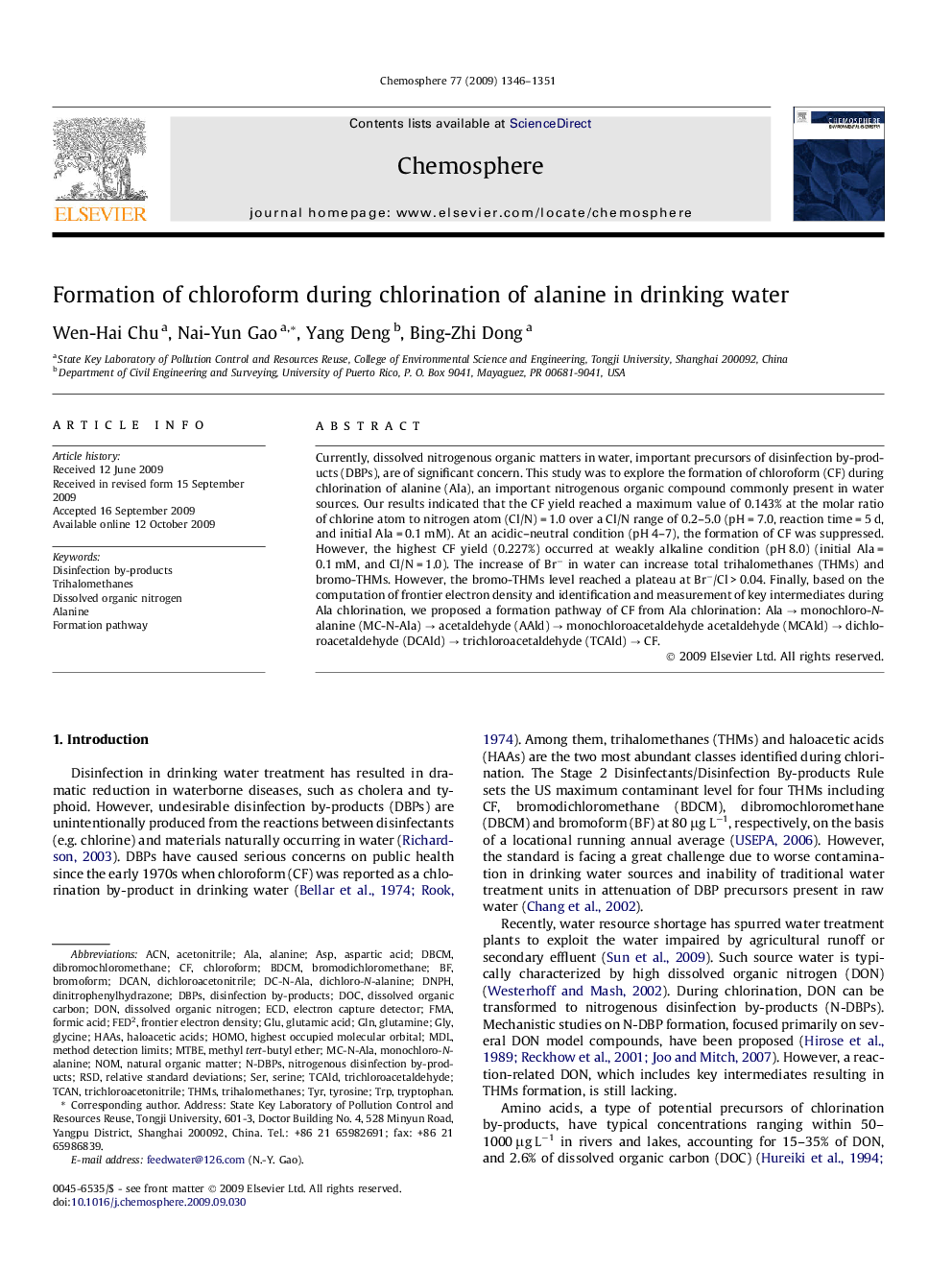| کد مقاله | کد نشریه | سال انتشار | مقاله انگلیسی | نسخه تمام متن |
|---|---|---|---|---|
| 4412202 | 1307628 | 2009 | 6 صفحه PDF | دانلود رایگان |
عنوان انگلیسی مقاله ISI
Formation of chloroform during chlorination of alanine in drinking water
دانلود مقاله + سفارش ترجمه
دانلود مقاله ISI انگلیسی
رایگان برای ایرانیان
کلمات کلیدی
RSDN-DBPsHAAsDinitrophenylhydrazoneGLNFMADBCMBDCMMDLdichloroacetonitrileDCANDBPsMTBEALAECDDOCDNPHACNASPAspartic acid - آسپارتیک اسدElectron capture detector - آشکارساز ضبط الکترونalanine - آلانینAcetonitrile - استونیتریلFormic acid - اسید فرمیکglutamic acid - اسید گلوتامیکHaloacetic acids - اسیدهای هالوسیتیکrelative standard deviations - انحراف استاندارد نسبیHomo - انسان، هوموhighest occupied molecular orbital - بالاترین مدول مولکولی اشغال شدهSER - برای بودنBromodichloromethane - برومودیکلورمتانBromoform - بروموفرمFrontier electron density - تراکم الکترون الکترون مرزیDON - دونDibromochloromethane - دیروروکلرومتانSerine - سرینDisinfection by-products - ضدعفونی کننده های جانبیmethyl tert-Butyl ether - متیل ترتل-بوتیل اترmethod detection limits - محدودیت تشخیص روشNitrogenous disinfection by-products - محصولات ضدعفونی کننده با اشعه گاماNatural organic matter - مواد آلی طبیعیNOM - نامDissolved organic nitrogen - نیتروژن آلی حل شدهDissolved organic carbon - کربن آلی حل شدهChloroform - کلروفرمGlu - گلوglutamine - گلوتامینGly - گلیGlycine - گلیسین
موضوعات مرتبط
علوم زیستی و بیوفناوری
علوم محیط زیست
شیمی زیست محیطی
پیش نمایش صفحه اول مقاله

چکیده انگلیسی
Currently, dissolved nitrogenous organic matters in water, important precursors of disinfection by-products (DBPs), are of significant concern. This study was to explore the formation of chloroform (CF) during chlorination of alanine (Ala), an important nitrogenous organic compound commonly present in water sources. Our results indicated that the CF yield reached a maximum value of 0.143% at the molar ratio of chlorine atom to nitrogen atom (Cl/N) = 1.0 over a Cl/N range of 0.2-5.0 (pH = 7.0, reaction time = 5 d, and initial Ala = 0.1 mM). At an acidic-neutral condition (pH 4-7), the formation of CF was suppressed. However, the highest CF yield (0.227%) occurred at weakly alkaline condition (pH 8.0) (initial Ala = 0.1 mM, and Cl/N = 1.0). The increase of Brâ in water can increase total trihalomethanes (THMs) and bromo-THMs. However, the bromo-THMs level reached a plateau at Brâ/Cl > 0.04. Finally, based on the computation of frontier electron density and identification and measurement of key intermediates during Ala chlorination, we proposed a formation pathway of CF from Ala chlorination: Ala â monochloro-N-alanine (MC-N-Ala) â acetaldehyde (AAld) â monochloroacetaldehyde acetaldehyde (MCAld) â dichloroacetaldehyde (DCAld) â trichloroacetaldehyde (TCAld) â CF.
ناشر
Database: Elsevier - ScienceDirect (ساینس دایرکت)
Journal: Chemosphere - Volume 77, Issue 10, November 2009, Pages 1346-1351
Journal: Chemosphere - Volume 77, Issue 10, November 2009, Pages 1346-1351
نویسندگان
Wen-Hai Chu, Nai-Yun Gao, Yang Deng, Bing-Zhi Dong,